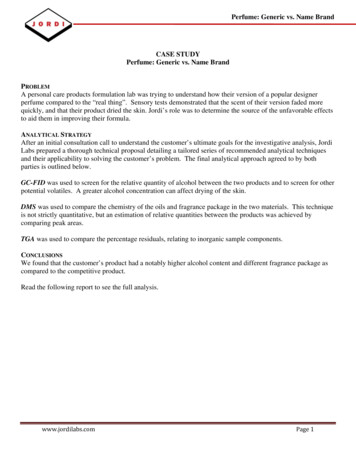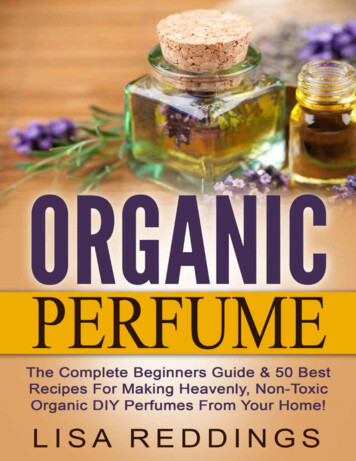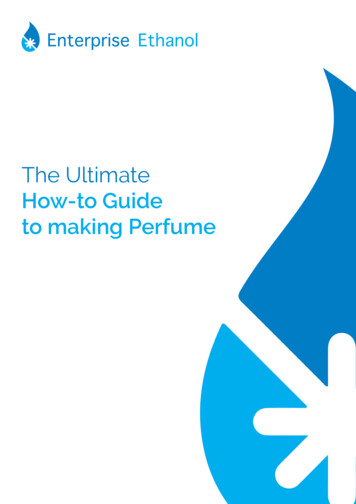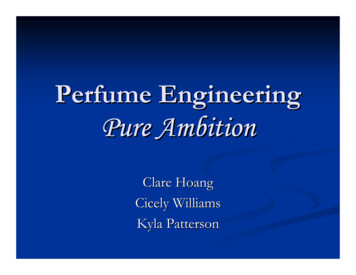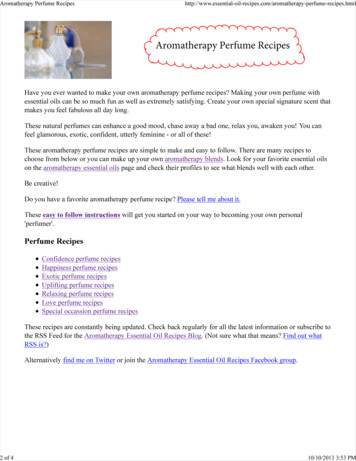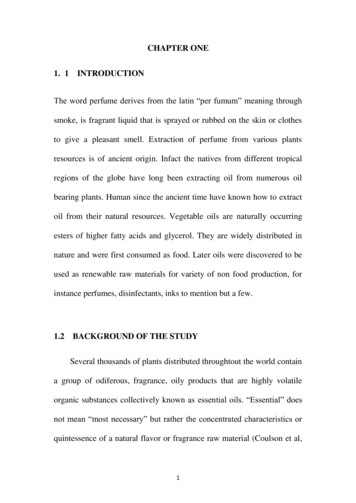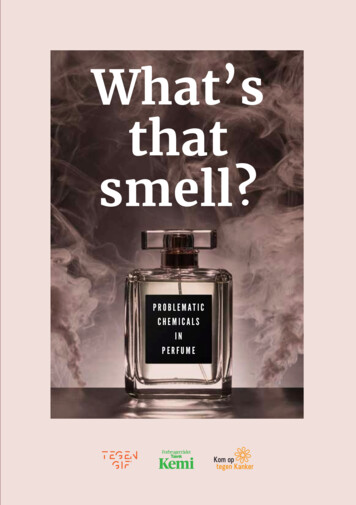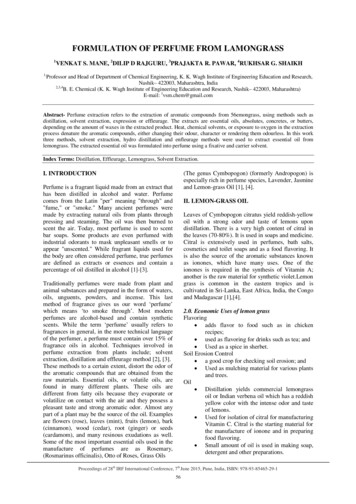
Transcription
FORMULATION OF PERFUME FROM LAMONGRASS1VENKAT S. MANE, 2DILIP D RAJGURU, 3PRAJAKTA R. PAWAR, 4RUKHSAR G. SHAIKH1,Professor and Head of Department of Chemical Engineering, K. K. Wagh Institute of Engineering Education and Research,Nashik– 422003, Maharashtra, India2,3,4B. E. Chemical (K. K. Wagh Institute of Engineering Education and Research, Nashik– 422003, Maharashtra)E-mail: 1vsm.chem@gmail.comAbstract- Perfume extraction refers to the extraction of aromatic compounds from 56emongrass, using methods such asdistillation, solvent extraction, expression or effleurage. The extracts are essential oils, absolutes, concretes, or butters,depending on the amount of waxes in the extracted product. Heat, chemical solvents, or exposure to oxygen in the extractionprocess denature the aromatic compounds, either changing their odour, character or rendering them odourless. In this workthree methods, solvent extraction, hydro distillation and enfleurage methods were used to extract essential oil fromlemongrass. The extracted essential oil was formulated into perfume using a fixative and carrier solvent.Index Terms: Distillation, Effleurage, Lemongrass, Solvent Extraction.(The genus Cymbopogon) (formerly Andropogon) isespecially rich in perfume species, Lavender, Jasmineand Lemon-grass Oil [1], [4].I. INTRODUCTIONPerfume is a fragrant liquid made from an extract thathas been distilled in alcohol and water. Perfumecomes from the Latin "per" meaning "through" and"fume," or "smoke." Many ancient perfumes weremade by extracting natural oils from plants throughpressing and steaming. The oil was then burned toscent the air. Today, most perfume is used to scentbar soaps. Some products are even perfumed withindustrial odorants to mask unpleasant smells or toappear "unscented." While fragrant liquids used forthe body are often considered perfume, true perfumesare defined as extracts or essences and contain apercentage of oil distilled in alcohol [1]-[3].II. LEMON-GRASS OILLeaves of Cymbopogon citratus yield reddish-yellowoil with a strong odor and taste of lemons upondistillation. There is a very high content of citral inthe leaves (70-80%). It is used in soaps and medicine.Citral is extensively used in perfumes, bath salts,cosmetics and toilet soaps and as a food flavoring. Itis also the source of the aromatic substances knownas ionones, which have many uses. One of theionones is required in the synthesis of Vitamin A;another is the raw material for synthetic violet.Lemongrass is common in the eastern tropics and iscultivated in Sri-Lanka, East Africa, India, the Congoand Madagascar [1],[4].Traditionally perfumes were made from plant andanimal substances and prepared in the form of waters,oils, unguents, powders, and incense. This lastmethod of fragrance gives us our word ‘perfume’which means ‘to smoke through’. Most modernperfumes are alcohol-based and contain syntheticscents. While the term ‘perfume’ usually refers tofragrances in general, in the more technical languageof the perfumer, a perfume must contain over 15% offragrance oils in alcohol. Techniques involved inperfume extraction from plants include; solventextraction, distillation and effleurage method [2], [3].These methods to a certain extent, distort the odor ofthe aromatic compounds that are obtained from theraw materials. Essential oils, or volatile oils, arefound in many different plants. These oils aredifferent from fatty oils because they evaporate orvolatilize on contact with the air and they possess apleasant taste and strong aromatic odor. Almost anypart of a plant may be the source of the oil. Examplesare flowers (rose), leaves (mint), fruits (lemon), bark(cinnamon), wood (cedar), root (ginger) or seeds(cardamom), and many resinous exudations as well.Some of the most important essential oils used in themanufacture of perfumes are as Rosemary,(Rosmarinus officinalis), Otto of Roses, Grass Oils2.0. Economic Uses of lemon grassFlavoring adds flavor to food such as in chickenrecipes; used as flavoring for drinks such as tea; and Used as a spice in sherbet.Soil Erosion Control a good crop for checking soil erosion; and Used as mulching material for various plantsand trees.Oil Distillation yields commercial lemongrassoil or Indian verbena oil which has a reddishyellow color with the intense odor and tasteof lemons. Used for isolation of citral for manufacturingVitamin C. Citral is the starting material forthe manufacture of ionone and in preparingfood flavoring. Small amount of oil is used in making soap,detergent and other preparations.Proceedings of 28th IRF International Conference, 7th June 2015, Pune, India, ISBN: 978-93-85465-29-156
Formulation Of Perfume From LamongrassFuel – the plants waste after oil extraction is used asfuel for distillation process [4].Medicinal Crushed leaves are applied to the foreheadand face as a cure for headache. Root decoction serves as a diuretic. Chewed leaves are held in the mouth toalleviate toothache. Acts as a mild diuretic, promotesperspiration and serves as an emmenagogue(agents that promote the menstrualdischarge). Excellent stomachic (stimulating thefunction of the stomach) for children. With black pepper, it is useful in checkingmenstrual disorders. A carminative and tonic to the intestinalmucus membrane; useful in cases ofvomiting and diarrhea. Lemon grass oil mixed with equal quantityof pure coconut oil makes liniments forlumbago, chronic rheumatism, neuralgia,sprains and other painful afflictions. It isalso helpful in treating ringworm. When taken internally, oil acts as stimulantand diaphoretic (having the property ofpromoting perspiration) [5].separation process. The content of the separatingfunnel was allowed to come to equilibrium, whichseparated into two layers (depending on theirdifferent density). The lower Ethanol extract and theupper Hexane layer were collected into two separate250ml beaker and were placed in a water bath at78oC. This was done to remove the Ethanol leavingonly the natural essential oil. The yield of oil wasdetermined by weighing the extract on an electronicweighing balance. The difference between the finalweight of the beaker with extract and the initialweight of the empty beaker gave the weight ofessential oil [2], [3], [6].V. STEAM DISTILLATION FOREXTRACTION OF LEMONGRASS OILThe set-up for steam distillation of lemon grass oilconsists of two distillation stills, condenser, andcollector. The distillation still has a capacity to hold1-1.5 kg of plant material per batch. Steam isgenerated by heating water in first still. Steam thusgenerated is passed in the second still. The two stillare connected by connecting tubes. A condenser isprovided between second still and connecter.Condenser consists of two connecting tubes. Water ispassed through outer tube and mixture of steam andoil passes through inner spiral tube. The condensedmixture of oil and water is collected in the collector.The whole apparatus is properly sealed to avoidleakage.Lemon grass (chopped or un chopped) isfilled in second still and its lid is fitted tightly, so thatoil and vapor do not leak out. Steam is injected in thesecond still with the help of connecting tube from thefirst still. The upcoming steam carries away the oilfrom the plant material i.e. lemon grass and both oilas well as steam pass to the condenser through vaporline, where these vapors are condensed and oil andwater are collected into the collector. Oil beinglighter floats on the surface of water. The mixture ofoil and water was separated in the separating funnel.The separating funnel is than kept for 24 hoursresidence time, after which water was removed anddiscarded from bottom whereas the oil was collectedin separate beaker. The oil thus obtained is lemongrass oil having 80-85% critical content and someunstable terpenes.III. USES OF PERFUMES The sense of smell is considered a rightbrain activity, which rules emotions,memory and creativity.Perfumes are used to mask body odor.Used to make people feel goodTo heal and cure physical and emotionalproblemsPerfumes are being revived to help balancehormonal and body energy.It helps to bolster the immune system wheninhaled or applied topically [1], [4].Smelling sweet smells also affects onesmood and can be used as a form ofpsychotherapy [5].IV. SOLVENT EXTRACTION METHOD130g of the dry sample of lemongrass were weighedfrom the sliced lemongrass sample and placed in a500ml clean flat bottom flask. 600ml of N-hexanesolvent were poured into the 500ml flask andstopped. The flask and content were allowed to standfor 24hrs; this was done to extract all the oil contentin the lemongrass and for complete extraction. Afterwhich the extract was decanted into another 500mlbeaker. 200ml of Ethanol were added to extract theessential oil since essential oil is soluble in Ethanol.The mixture was then transferred to 500ml separatingfunnel and separated by a process called liquid/liquidVI. THEORYEssential oils are highly heat sensitive, as suchdistillation and fractionation is to be carried out atlow temperature and low atmospheric pressures. Incase of fractionation, vacuum pumps are used forthese purpose, while in case of steam distillation,pressure lowering effect is achieved by lower partialpressure of the feed components, enablingvaporization at sub-atmospheric conditions.Further, direct contact heat transfer provided bysteam, initially gives wet ability to the grass at lowerProceedings of 28th IRF International Conference, 7th June 2015, Pune, India, ISBN: 978-93-85465-29-157
Formulation Of Perfume From Lamongrasstemperatures, enhancing diffusion and osmosis of oil.Rate of oil vaporization of plant material by steamdistillation is not influenced by relative volatility ofoil components but by their solubility in water (invapor phase). Extraction of essential oil from lemongrass by steam distillation is an effective process.Also, oil removed per unit time is directlyproportional to oil remaining in the grass. So thesimplest rate equation is given by first order kineticsas:VIII. KINETIC STUDIESTable 1 showed the oil produced within 150min and300min for 600gm finely chopped, 600gm roughlychopped and 400gm finely chopped lemongrass. Fig.1 showed that the yield of oil is higher for finelychopped lemongrass since high surface area for finesize. Table 5 gives the Gas chromatography – Massspectroscopy analysis of lemongrass oil produced.The kinetic data i.e. oil yield for all the 3 experimentsis presented in Table 2, 3 & 4. Fig 2 shows the plotsof oil yield v/s time for these experiments. Besidesthis, as mentioned in theory section, fractional yieldof oil, u, was also calculated for these experimentswhich is defined as followsu (oil extracted till time‘t’)/ (cumulative amount ofoil extracted)In order to verify the rate model as described in thetheory section ln 1 /(1 u (t )) v/s t, was plotted fortwo experiments. All the plots show the straight linebehavior.Normally for first order kinetics these straight linesshould pass through the origin, but in case ofexperiments this straight line does not pass throughorigin, but have intercept on x-axis i.e. time axis. Butin case of second experiment straight line passesthrough origin which indicates that secondexperiment perfectly follows first order reactionkinetics. It was noted that in case of experiment no 2,the plant material was thoroughly wetted by hot waterfor 10-15 mins inside the distillation still andthereafter the steam was injected whereas in all otherexperiments steam was injected directly to the dryplant material.Thus, the time axis intercept in all the otherexperiments indicate that oil is not instantly releasedafter injection of steam into the dry grass, but forinitial 10-15 mins in period, the steam wets the dryplant material, which in turn helps in diffusion andosmosis of oil from inside the plant material to thesurface of the individual grass strands, and once theoil is on surface of grass/plant material, it is beingcarried away by steam. After this initial period ofwetting, extracting of oil by steam distillation followsfirst order kinetics behaviorTable 1. Yield of lemongrass oil after 150min and300 minTable 2. Oil yield and fractional yield of oil valuesfor experiment 600gm finely chopped lemongrassFig. 1. Yield Of Lemongrass Oil Vs TimeFig. 1. First Order Kinetics For 600gm Finely ChoppedLemongrass Thus on integrating on both sides,Where,m average concentration of essential oil in grass atany time‘t’mo initial concentration of essential oil before steamdistillation starts.t time for steam distillationu( t ) fraction of oil extracted.If the above model holds good then the plot ofln 1 /(1 u (t )) v/s t shall produce straight linepassing through origin. VII. RESULTS Proceedings of 28th IRF International Conference, 7th June 2015, Pune, India, ISBN: 978-93-85465-29-158
Formulation Of Perfume From LamongrassTable 3. Oil yield and fractional yield of oil valuesfor experiment No. 2 (600 gm roughly chopped)Table 5. GC-MS result for lemon grass oilIX. FORMULATION OF PERFUME WITHESSENTIAL OIL PRODUCEDApparatus and Reagents and methodVarious apparatus and reagents needed like Funnel,50ml and 120ml beakers, Perfume bottle, Fixatives(Surprise and Dream), Alcohol, Distilled water andLemongrass essential oil10ml of lemongrass essential oil extract weremeasured and placed in a beaker containing 5ml ofalcohol. 5ml of the Fixatives were added to themixture (to improve the longevity of the perfume).The solution were shaken and poured into a bottle.Fig. 2. First Order Kinetics For 600gm Roughly ChoppedLemongrassTable 4. Oil yield and fractional yield of oil valuesfor experiment No. 3 (400gm of finely chopped)CONCLUSIONYield of oil from solvent extraction method is greaterthan the yield obtained from steam distillationmethod and in steam distillation method the yieldfrom finely chopped lemon grass is more than fromcoarsely cut lemon grass, because it provides largesurface area. Kinetic studies of steam distillationprocess showed that oil is not instantly extracted, ifsteam is injected to the dry grass, but wetting orswelling of the grass inside the distillation still isneeded for initial 10-15 mins for diffusion andosmosis of oil inside the grass. Extraction of oil bysteam distillation of lemon grass follows first orderkinetics. GC-MS result shows that citral-A and citralB are major components of lemon grass oil. It alsocontains myrcene, limonene, and linalool in certainamounts. It also contains many stable componentssuch as aldehydes, ketones, esters. It also containsunstable components terpene which has to beremoved by fractional distillation. The perfumewhich we have formulated from lemon grass has niceand pleasant smell.Fig. 3. First Order Kinetics For 400gm Finely ChoppedLemongrassProceedings of 28th IRF International Conference, 7th June 2015, Pune, India, ISBN: 978-93-85465-29-159
Formulation Of Perfume From LamongrassREFERENCES[1][2]M. Idrees , T. A. Dar, M. Naeem, Tariq Aftab, M. M. A.Khan, A. Ali, Moin Uddin, and L. Varshney, “Effectsof gamma-irradiated sodium alginate on lemongrass:field trials monitoring production of essential oil”, Ind.Crops Products, vol. 63, pp. 269–275, Jan. 2015.J. Moncada, J. A. Tamayo, and C. A. Cardona,“Techno-economic and environmental assessment ofessential oil extraction from Citronella (Cymbopogonwinteriana) and Lemongrass (Cymbopogon citrus): A[3][4][5][6]Colombian case to evaluate different extractiontechnologies”, Ind. Crops Products, vol. 54, pp. 175–184, March 2014.J. B. Cannon, C. L. Cantrell, T. Astatkie, and V. D.Zheljazkov, “Modification of yield and composition ofessential oils by distillation time”, Ind. Crops Products,vol. 41, pp. 214–220, Jan. ction.htm. Proceedings of 28th IRF International Conference, 7th June 2015, Pune, India, ISBN: 978-93-85465-29-160
Proceedings of 28th th IRF International Conference, 7 June 2015, Pune, India, ISBN: 978-93-85465-29-1 56 FORMULATION OF PERFUME FROM LAMONGRASS 1VENKAT S. MANE, 2DILIP D RAJGURU, 3PRAJAKTA R. PAWAR, 4RUKHSAR G. SHAIKH 1,Professor and Head of Department of Chemical Enginee
